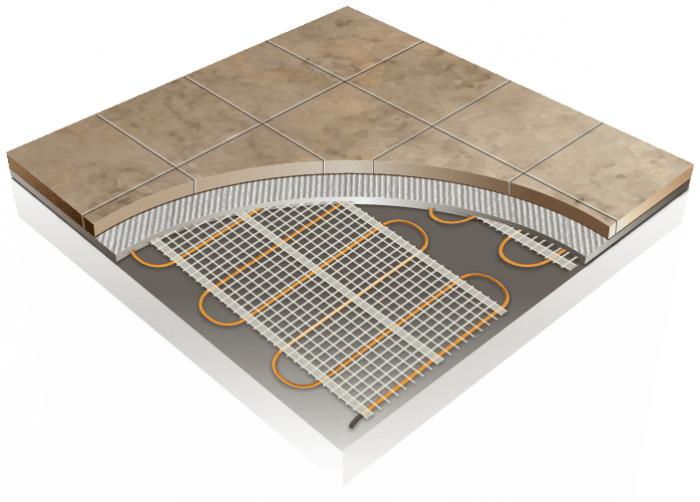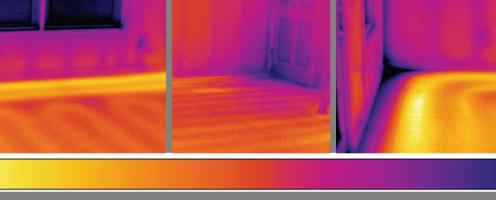Among modern heating systems, one of the main places is occupied by a water or electric underfloor heating under tiles. Which one is the best to choose is not an idle question. Comfort in the home and energy savings depend on this. Water heating is prohibited in multi-storey buildings. Therefore, heating the house with underfloor heating is done mainly with the help of electricity. Heating is controlled by a thermostat mounted on the wall.
The advantage of this method is the uniform heating of the room. At the same time, a decrease in the average temperature in the room by 2-3 ° C will not cause discomfort. Electricity savings will be 10-15% here. Especially required is a warm floor for tiles or ceramic tiles, cold for the feet.
Types of heaters
Heat is generated by the following heating elements embedded in the floor:
- cables;
- mats;
- infrared film.
The modern market offers various options. It remains to choose an electric underfloor heating under the tiles. Which is better? Let's try to figure it out. 
Cables
Cables are resistive and self-regulating. All of them are mounted with reinforcement, which takes 3-5 cm of additional room height. In addition, tiles are laid on top, taking up to 2 cm more.
Resistive cable
When electric underfloor heating is installed, the prices are the lowest for a resistive heating cable, which can be one- and two-core.  When an electric current passes through it, heat is generated. The cable has a constant power. It can be laid at will in rooms with complex floor shapes.
When an electric current passes through it, heat is generated. The cable has a constant power. It can be laid at will in rooms with complex floor shapes.
Self-regulating cable
This type of cable differs in its principle of operation. It consists of two conductors in parallel. A semiconducting polymer is placed between them. A current passes through it in the transverse direction. In different areas, the heat generation in the cable can be different, depending on the temperature in the room. Therefore, there will be no overheating in some places if there will be furniture or household appliances. It is important that too much stress does not damage the cable.
Mats
It is up to the homeowner to decide what kind of underfloor heating to install under the tiles, but heating mats made from an ultra-thin cable glued to the mesh are best.  They are made in the form of rolls of different widths, with a capacity of 130-150 W. The mats are easily connected with each other with terminals. The assembly is reliable if the joints are additionally glued with tape or smeared with a special sealant. The connections to the cable to the thermostat protrude slightly, but they can be sealed into recesses in the floor or wall. High strength and durability of cable insulation does not require mandatory installation in a sand-cement screed. Mats can be placed in a layer of tile adhesive without waterproofing. The thickness of the warm floor will turn out to be insignificant.
They are made in the form of rolls of different widths, with a capacity of 130-150 W. The mats are easily connected with each other with terminals. The assembly is reliable if the joints are additionally glued with tape or smeared with a special sealant. The connections to the cable to the thermostat protrude slightly, but they can be sealed into recesses in the floor or wall. High strength and durability of cable insulation does not require mandatory installation in a sand-cement screed. Mats can be placed in a layer of tile adhesive without waterproofing. The thickness of the warm floor will turn out to be insignificant. 
Film infrared floor
The heater consists of flat carbon conductors laminated into a roll from a special electrical film. This option was originally designed to be installed under floor coverings without screed or glue. Not every film floor can withstand interaction with the alkaline environment of mortars. It can be used under tiles, but additional waterproofing made of polyethylene is required.
Selecting the power of the heaters
When it is planned to make an electric underfloor heating under the tiles, which one is best suited in terms of power, depends on the type of room.
Determination of the usable area
Heating is not done under bulky furniture and household appliances due to overload and disruption of normal air circulation. It should be borne in mind that it is advisable to heat at least 70% of the floor of the room when electric heating is the main source of heat. Moreover, its specific power should be 110-220 W / m 2. If the usable area is less, you will have to abandon the electric floor or change the layout of the room. For the kitchen or living room, the power is approaching the lower limit, and in the bathroom, on the loggia or in the premises of the first floor, more is required. The best option is to operate the heating system at 70-75%.
How to calculate when buying
Before you make a warm floor at home, you need to correctly calculate the power, which depends on the type and area of the room. The figure below shows through a thermographic device with heating of different power (surface temperature 15-25 ° C). 
The room requires a specific power of 100-160 W / m 2. For an auxiliary heat source, it can be selected to a minimum.
For a room of 20 m 2, the usable area will be 20 70/100% = 14 m 2.
Then the required power will be W = 100 14 = 1.4 kW.
When the source is the main one, you need to take the maximum: W = 160 14 = 2.24 kW.
The cost of a resistive cable is not very high, and it makes sense to take it as the main source of heating, which does not have to be 100% used.
If the power of the cable is 20 W / m, then the main source needs a length
L = 2.24 1000/20 = 112 m.
Special couplings are installed at the ends of the cable. Therefore, they are sold in fixed lengths. When purchasing, you can choose a cable with the required power, close to the calculated one.
How to install a warm floor
When laying an electric underfloor heating with your own hands, you should know that thermal insulation is needed from below. It is not worth saving on it, since it is a reliable thermal protection of the house. In addition, all the heat generated by the warm floor will go up into the room.



